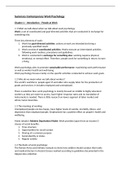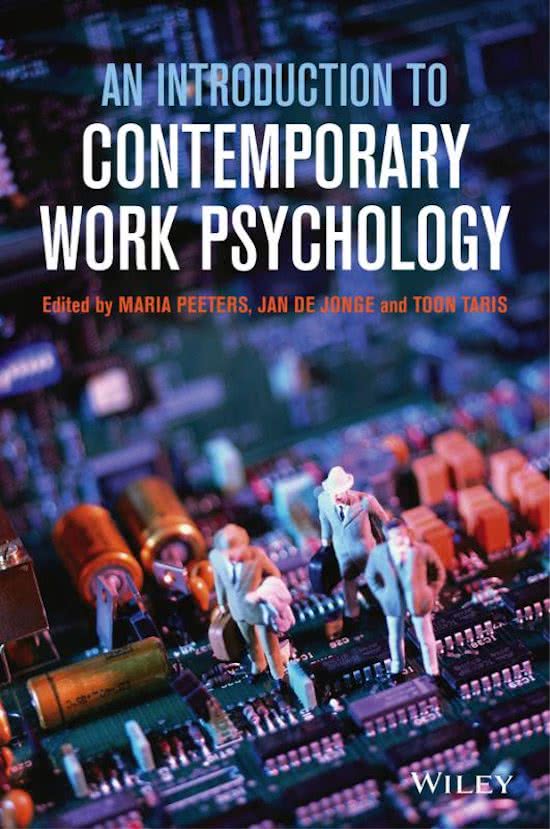Summary Contemporary Work Psychology
Chapter 1 – Introduction – People at Work
1.1 What we talk about when we talk about work psychology
Work: a set of coordinated and goal-directed activities that are conducted in exchange for
something else.
Three key elements of work:
1. Work has goal-directed activities: actions at work are intended dot bring a
previously specified result.
2. Work consists of coordinated activities. Works execute an interrelated activities
following work routines, procedures and guidelines.
3. Work is conducted in exchange for something else: working requires physical,
emotional, or mental effort. Therefore, people work for something in return; to earn
a living.
Work psychology aims to promote sustainable performance: maximizing work performance
as well as worker health and well-being.
Work psychology focuses mainly on the specific activities conducted to achieve work goals.
1.2 Who do we mean when we talk about workers?
The world’s workforce: people aged 15 and older who supply labor for the production of
goods and services. It includes employed and unemployed.
There is selection bias: work psychology is mainly focused on middle to highly educated
workers as they are easier to access, have higher response rates and no translation of
instruments is needed. There is little research on lower segment of labor market and
ethnic/racial minorities.
1.3 The meaning of working
Unemployed people are less happy, have higher levels of suicide, mortality, illness, and
depression than employed people. Employment has a positive effect on people’s health and
wellbeing.
Marie Jahoda’s Relative Deprivation Model: Work provides (apart from an income) 5
classes of social benefits:
1. Time structure
2. Opportunities for social contact
3. Sharing of a common purpose
4. Social identity or status
5. Regular activity
1.4 The Roots of work psychology
The Roman Army used military manuals to show how soldiers should conduct their tasks
and medical doctors in Ancient Greece worked according to guidelines documented in the
Hippocrates collection.
,In the 1500s, the first scientific texts on the association between work and health appeared.
Agricola documented the impact of working in mines on the health of miners.
During the industrial times: psychotechnics focuses on how workers can be motivated to
work hard and how can they be made more productive. Employees often had simple,
repetitive, and boring work requiring few skills.
Frederick Taylor found the scientific management approach (or Taylorism). His theory had
two assumptions: workers were lazy and stupid.
Taylor’s proposal to counter the stupid issue:
1. Simplifying tasks using scientific methods: complicated tasks broken down into
smaller, simpler tasks.
2. Examining the best way to accomplish this task: there is only one best way to
accomplish this task, other approaches are discouraged.
3. Training workers in the ‘one best way’: resulting in higher productivity.
4. Separating the planning of tasks from their execution: how their tasks should be
conducted should be decided for them by supervisors.
5. Selecting workers for a particular task.
Taylor’s proposal to counter the lazy issue:
1. High levels of control and supervision
2. Pay-for-performance systems
The Scientific management approach affected workers morale negatively.
Frank and Lillian Gilbreth developed time and motion studies: they filmed the worker’s
activities to make an analysis of how the work had been done and seeing where
improvement was possible. They optimized the motions involved rather than by reducing
process ties, as Taylor had done.
The Human Relations Movement fit the job to the worker. Employees offered pensions, sick
pay and educational programs. The focus was on developing friendships resulting in being a
team.
1.5 The times, they are a-changin’
The five most important changes in our work in the past few decennia:
1. The changing nature of work: increase in service sector and knowledge worker,
decrease in manufacturing jobs.
2. The changing workforce: workforce used to be more homogeneous: same ethnic
background, male and worked for the same employer their whole life. Now: diverse
workforce with various genders, ages, ethnicity, and educational background.
3. The changing flexibility of working: employees have high work flexibility:
Flexibility in timing of work
Flexibility in place for work (at home/office)
Facilitation of new media technologies (smartphone, videocalls)
4. The changing organization: globalization and ICT
, 5. The changing psychological contract: employees are expected to move between
organizations more often. Education and training are more common which improves
employability.
All these things lead to intensification of work: increasing work hours and work pressure.
1.6 The Crucial role of task analysis in Contemporary work psychology
Task analysis is any process that identifies and examines the tasks that must be performed
by employees. There are 4 different approaches:
1. Behavior description approach: actual behavior employees display in executing the
task: e.g., mopping the floor.
2. Behavior requirements approach: actual behavior employees should display to
perform the task successfully: showing dedication.
3. Ability requirements approach: tasks are analyzed in terms of employees’ abilities,
knowledge, skills, and personal characteristics.
4. Task characteristics approach: analyze the objective characteristics of a task,
independent from the behavior that is actually displayed or that should be displayed,
or the abilities needed.
Task analyses techniques are divided in three categories:
1. Data-collection techniques
2. Task-representation, techniques
3. Task-simulation techniques
Chapter 2 – Research Methods in Work Psychology
Hypothesis: testable prediction about the world
Hypothetical/Abstract constructs: label the concepts that we cannot directly observe in
order to organize observations in a meaningful way
Operational definition: define an abstract construct in specific, observable, measurable,
behavioral.
2.1 Measurement
Scale Meaningful Equal Fixed Origin? Examples
order? Distance?
Nominal No No No Assigning numbers to organizational
departments:
1=engineering
2=research
3=marketing
Ordinal Yes No No Assigning numbers to employees in terms
of performance:
1=Zara (top salesperson)
2=Heinrich (second-best salesperson)
3=Miko
Interval Yes Yes No Having supervisors rate their sales
, performance
Ratio Yes Yes Yes Calculating the value of product sold:
Zara=500.000
Heinrich=300.000
Miko=250.000
Nominal level:
Uses numbers as labels/names.
Labels are not meaningful and do not allow for interference
Ordinal level:
Conveys information about rank order and similarity/differences.
Ranks do not give information on how far apart they are
Interval level:
Incorporates notion of magnitude of difference
Have equal intervals
Difference between 1 and 2 is the same as the difference between 3 and 4
Ratio level:
Has equal intervals
Has a true zero: score of 0 means absence of the quantity being measured.
2.2 Classical Test Theory
Formula of the classical test theory (CTT) is:
X=T+e
X: observed score (actual test score)
T: real score
E: error component
Reliability: extent to which measurement reflects the ‘true’ score and is free of random
errors, such that items consistently measure the same construct.
Approach Assesses
Test-retest reliability The degree to which the same test measures the same thing on two
different occasions
Alternative forms The extent to which 2 different but equal forms of tests measure the
reliability same thing
Split-half reliability The degree to which 2 halves of the same test measure the same thing
Inter-rater reliability The consistency of the observations across different raters
Internal consistency The degree to which all items on a test are measuring the same thing
Validity: whether or not the test is measuring what we think it is measuring.
Reliability is necessary but not sufficient condition for validity.






